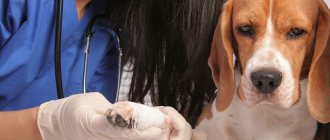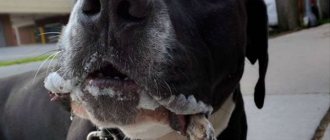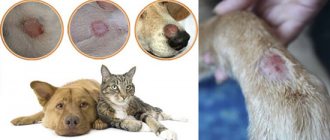What is a stroke and a microstroke?
First, a little terminology. Stroke (from the Latin insultus “blow”) is an acute disorder of cerebral circulation, leading to the gradual death of cells and the death of entire parts of the brain.
Depending on which part of the brain is damaged, after a stroke the tailed patient loses the ability to move normally and perform functions usual for healthy animals.
There is also such a thing as a microstroke - a harbinger of a real major stroke. In the case of a transient ischemic attack, which is what, according to medical terminology, is called a microstroke, the congestion formed in the vessel resolves on its own without medical assistance. However, several micro-strokes are comparable to one large blow and also carry dangerous irreversible consequences.
Symptoms of cerebrovascular accident
Every owner must remember that even if his pet is completely healthy and not at risk, a stroke can happen at any time.
Try to remember the main symptoms of this disease and give your pet enough attention every day. What are the most common signs of stroke in dogs? If cerebral circulation is impaired, the animal may behave aggressively or, on the contrary, be lethargic and sleepy. If a well-mannered pet suddenly stops obeying its owner and responding to commands, this is an alarming symptom. Impaired coordination of movements and partial paralysis may be external manifestations of a stroke. Some animals experience a distortion of the muzzle (impaired muscle function) and a change in the size of the pupils. In severe cases, a stroke in a dog has the following symptoms: disturbances in heart rhythm and breathing, fainting and seizures, coma.
Causes of stroke
The causes of stroke in dogs are:
- heart pathologies;
- hypertension;
- obesity;
- autoimmune diseases;
- traumatic brain injuries, concussions;
- severe helminth damage affecting the brain;
- poisoning;
- poor functioning of internal organs, for example, the thyroid gland, kidneys, liver;
- aneurysm or other vascular abnormalities;
- blood thickening;
- atherosclerosis;
- hormonal disbalance;
- severe shock or stress;
- tumors in the brain.
Signs if your dog has had a stroke
The first symptoms of a stroke in dogs can be seen with the naked eye: any owner of a four-legged friend, even an inexperienced one, will see changes in the pet’s behavior. When a stroke begins, a dog becomes frightened, overly excited, does not respond to voices or weakly, and is unable to follow commands.
Usually, during a stroke in its initial stage, the animal either walks in circles or wanders around the apartment. Sometimes the dog comes up to the wall and rests its forehead against it: it can stand this way for quite a long time. The animal can also rest against the floor. Dogs with increased nervous sensitivity are likely to panic and become aggressive.
With these symptoms, the owner needs to gather his strength, not think for a long time, and urgently take the animal to the veterinarian, or call a specialist to the house. With this disease, it is vital to get your dog medical attention as early as possible.
Note, however, that symptoms can sometimes be almost invisible. If a micro-stroke occurs, the dog may not react to it at all, but simply sleep or lie down more. Let us note, however, that in this case the dog’s general condition will be painful: he will have no appetite, apathy will appear for walks, to strangers, and the dog will no longer react adequately to his beloved owners.
More symptoms:
- Motor activity in one or more paws may be lost.
- Often with a stroke, asymmetry of the muzzle is noticeable - the animal’s eyelid or lip droops down.
- It is noticeable that the dog's pupils are of different sizes. They also respond differently to light stimuli, with one pupil being slower than the other.
- There is a decrease in the dog’s vigilance, and the animal also breathes unevenly and with difficulty. Often when a dog has a stroke, it curls up into a ball.
If the stroke is severe, the dog may go into a coma. In this case, the animal lies on its side and makes no movements at all. At the same time, her eyes become glassy, which, in combination with a motionless body, can thoroughly frighten the owner
Note that sometimes very little time passes from the moment the first symptoms appear until the dog falls into a coma. Therefore, it is necessary to urgently provide veterinary care to the animal. If help is not provided in the first three hours after a stroke, the dog is likely to become disabled or die.
Symptoms of the disease
The following signs will help you recognize a stroke in your pet in time and seek help from a veterinarian:
- the dog has become unusually lethargic, apathetic, or, on the contrary, overly active and even aggressive;
- the animal does not respond to its name, as if it does not recognize you, it looks confused;
- the dog has problems swallowing food and water;
- a clear asymmetry appeared on the muzzle;
- the pet begins to limp or lies completely motionless;
- labored breathing;
- convulsions, seizures resembling epileptic ones;
- dilation of one or both pupils;
- vomit;
- coma.
Canine microstroke is not characterized by such striking manifestations. However, if your pet refuses food, behaves strangely, for example, wanders aimlessly in circles around the apartment, refuses to go outside - immediately go to see a doctor.
Symptoms and signs of the disease
Dogs suffering from stroke experience:
- Change in behavior (can be either depressive or hyperactive).
- Violation of visual and respiratory functions.
- Muscle weakness (it is associated with the degree of damage to the brain and one side of the body; the pet in this case will take a ring pose, twisting its whole body).
- Poor coordination of movement (the dog may stagger when walking).
- Keeping your pet in one place for a long time.
- The appearance of epileptic signs.
- The onset of coma (considered the most severe case - the dog suddenly falls on its side, lies motionless, with glassy eyes).
A disease such as a stroke can occur in a dog at any second; it is quite easy to confuse it with some other ailment (for example, with manifestations of epilepsy in mild symptoms) and miss it. The owner of the dog should under no circumstances wait for the dog to show signs characteristic of a stroke; he will have to immediately contact the nearest veterinary clinic, or call a specialist veterinarian to his home.
Types of stroke
There are two types of stroke: ischemic and hemorrhagic.
- An ischemic stroke or cerebral infarction provokes a disruption of the blood supply. Ischemic stroke occurs four times more often than hemorrhagic stroke. The main culprit of this scourge is a diseased heart, which has lost the ability to pump blood well and deliver it to the internal organs, including the brain.
- Hemorrhagic stroke, in turn, is characterized by rupture of a vessel and release of blood into the intracranial space. And although this type is the least common (occurs in only 25% of cases), it leads to the most severe consequences.
Causes of pathology
First, all dogs that are severely overweight are at risk . If your pet looks more like a well-fed kolobok than a wild wolf, things are bad. His cardiovascular system is heavily overloaded, and this is fraught with disruptions in the blood supply to the brain. In addition, overtly chubby animals have a very high risk of fat embolism. Simply put, a “stack” of lipids that “precipitated” into the bloodstream from destroyed lipocytes can block the lumen of blood vessels. This can happen anywhere, but if the pathology develops in the brain or heart (blockage of the coronary artery), the animal will most likely die. Or, as an option, he will develop a stroke. If it happens and your pet survives, be sure to adjust its diet, if necessary, with the help of a professional veterinary nutritionist.
Secondly (which follows from the first), the risk of pathology is increased in those dogs whose owners “don’t bother” with feeding their pet. Simply put, if an animal is constantly fed monotonous food, its diet contains a lot of carbohydrates, but few vitamins, micro-, macroelements , the chances of developing circulatory pathologies naturally increase. Please note that problems with the nutrition of brain cells can be caused not only by a decrease in the volume of blood passing through the vessels, but also by a deterioration in its “quality”. When the food given to an animal is low in iron and protein , little hemoglobin is synthesized in its body.
Little hemoglobin = little bound oxygen. We already know what its deficiency can do for the brain. The conclusion is simple - monitor the quality of your pet’s diet, save a lot of nerves and money, since the consequences of a stroke are extremely severe.
Who gets a stroke more often than others?
It should be noted that dogs are less susceptible to this terrible scourge than we are. Animals have fewer bad habits: they do not smoke, do not drink alcohol, but it is these human addictions that become the main provocateurs of stroke.
However, dogs also have their own risk group. It includes:
- older dogs;
- excitable dogs with unstable psyches;
- large breeds;
- animals prone to heart disease, for example, Boxer, St. Bernard, Malamute.
Forecast
Since the disease is quite serious, and timely diagnosis is available in very rare cases, the prognosis is cautious.
Many even veterinary specialists believe that microstroke and stroke are diseases that cannot be diagnosed and naturally cannot be treated, and thus doom animals to death.
Quick and complete diagnosis of micro-strokes in dogs is, of course, a matter of the future, but everything possible must be done now.
Old animals need to be treated with aspirin. Twice a year (possibly in spring and autumn), it must be given to the dog with food, ¼ tablet 2 times a day for 2 weeks. This event will prevent cerebral thrombosis.
To prevent thrombosis, older dogs are given aspirin.
What common neurological diseases of dogs “masquerade” as a stroke?
There are several diseases that are often confused with stroke because their symptoms are incredibly similar:
- Peripheral vestibular syndrome. It is this that is more often than other ailments mistaken for a stroke. The exact causes of the development of this disease have not yet been identified, but it is believed that the main “lever” is age-related changes in the vestibular apparatus. In the absence of obvious organic lesions, the animal seems to be lost in space and ceases to distinguish the horizon line. The dog falls, walks in a circle, holds its head at an angle. Asymmetry appears on the muzzle, the eyes constantly move from side to side.
- Central vestibular syndrome. In appearance it resembles peripheral, although in this case the zones of the pons, medulla oblongata and vestibular nuclei are affected. The main sources of troubles are cysts and other neoplasms affecting these parts.
Please note that only an experienced veterinarian can make an accurate diagnosis after a thorough diagnosis.
Prohibited actions
It is important that at home it is strictly forbidden to “treat” the dog yourself and prescribe it medications and drugs, especially human ones. You should also not put ice or cooling bandages on your pet’s head. Cold provokes spasm of the head vessels and will complicate the situation.
Medical assistance should only be provided by a doctor, so at the first symptoms, immediately go to a veterinary hospital. The first three hours are the most important to saving your dog.
Before transportation, you will have to relieve the animal's condition. To do this you need:
- Remove the collar from your neck.
- Give the animal water.
- If the dog is overly excited and scared, you can add herbal sedatives to the water, for example “Bayun”, “Fidex”.
- In the car, be sure to place your pet on its side so that if it becomes nauseous, it does not choke on vomit.
- If your dog is drooling a lot, wipe the dog's mouth with a napkin or bandage.
- Be sure to talk to your pet in a quiet, calm voice the whole way, calm him down by gently stroking him.
Treatment
Stroke in a dog should only be treated in a clinic. Therapy goals:
- provision of emergency care, relief of acute symptoms;
- maintaining body functions;
- eliminating the cause of the attack.
Drug therapy includes the use of several multidirectional groups of drugs.
Taking nootropic drugs activates plastic processes in nervous tissue and improves brain function. Modern nootropics:
- Piracetam;
- Nootropil;
- Sermion.
To restore brain activity, the dog is given:
- Cordiamine;
- Sulfacamphocoin.
For paralysis, Proserpine is prescribed. It improves the functioning of skeletal muscles. Ascorbic and succinic acid accelerate the restoration of nerve tissue. Convulsive manifestations are eliminated with the help of Benzonal. For muscle spasms, Mydocalm is indicated.
To relieve swelling, you need to take diuretics:
- Furosemide;
- Mannitol.
Learn about the first signs of intestinal obstruction in dogs, as well as methods for treating the pathology.
How and how to treat abdominal dropsy in dogs? Effective treatment options are collected in this article.
On the page, read about what you can give your dog for diarrhea and how to calculate the dosage of medications.
If a dog experiences severe psychomotor agitation, tranquilizers are prescribed:
- Seduxen;
- Relanium.
Often a stroke causes problems with swallowing function. To maintain the vital functions of the body, infusion therapy is carried out. Intravenous injections of glucose, plasma substitutes and other solutions are given.
On average, treatment takes about 10 days. In more severe cases, it can last 1-1.5 months.
Modern approaches to the treatment of disease in veterinary clinics
After all diagnostic measures and a comprehensive examination, the veterinarian will make a diagnosis and only then prescribe treatment. If a stroke is confirmed, the dog will be prescribed anticonvulsants, painkillers, drugs that restore cerebral circulation, vitamins, antipsychotics, and tranquilizers.
Most likely, the animal, especially in serious condition, will remain in the hospital for several days under the supervision of staff. As soon as the patient’s condition has stabilized, he will be discharged home under the responsibility of his owners. Owners will have to strictly follow all doctor's instructions and adhere to the prescribed medication regimen.
Stroke treatment
After making an accurate diagnosis and assessing the patient’s condition, the doctor prescribes medication. The first 3-5 days after a stroke are considered the most difficult. The statistics are frightening, but it is during this time period that the probability of death is 50%. If necessary, the veterinarian can leave the dog in the clinic’s hospital for constant monitoring and the most effective treatment. Regular therapy is prescribed for 10-15 days, during which the animal must be regularly examined by a doctor. During this time, the patient continues to receive medications, rest and a therapeutic diet are recommended. In severe cases, dogs after a stroke may be given medication and monitored for up to a month and a half.
Rehabilitation after stroke
In addition to drug treatment, you will have to make a lot of efforts to restore your pet. Here are some recommendations for caring for such patients:
- Diet. During this period, the animal is fed liquid or crushed easily digestible food.
- Massage. Most likely, the attending physician will prescribe a course of massage. Remember to vary your doggy position to avoid bedsores.
- Room temperature. Protect your dog from drafts, remove wet diapers in a timely manner and make sure that the baby does not freeze. Now his body is very weakened and the risk of developing dangerous pneumonia is incredibly high.
- Physiotherapy. Can be prescribed as an additional method of rehabilitation.
Rehabilitation
The duration of the recovery period depends on many indicators:
- forms of stroke;
- extent of brain damage;
- timely provision of first aid;
- age and health of the dog.
In the ischemic form of the disease, which has affected minor areas of the brain, there is a chance of complete restoration of activity within 1-1.5 months. In severe cases, when there are neurophysical lesions, rehabilitation can take months. But no one can guarantee a 100% positive result. Many dogs have to adjust to a new physical disability after a major stroke.
After returning from the clinic, the animal needs to be provided with proper care:
- the room should be warm, without drafts;
- lay dry, but not very soft, bedding, change it as often as possible;
- periodically change the dog’s position to avoid bedsores;
Helps restore the body:
- massage;
- electrophoresis;
- magnetic therapy;
- reflexology.
One of the conditions for effective rehabilitation should be proper nutrition. You need to feed your dog in small portions. Food should be homogeneous, semi-liquid. It should contain a maximum of nutrients and vitamins. Products should be high in calories, but easily digestible.











